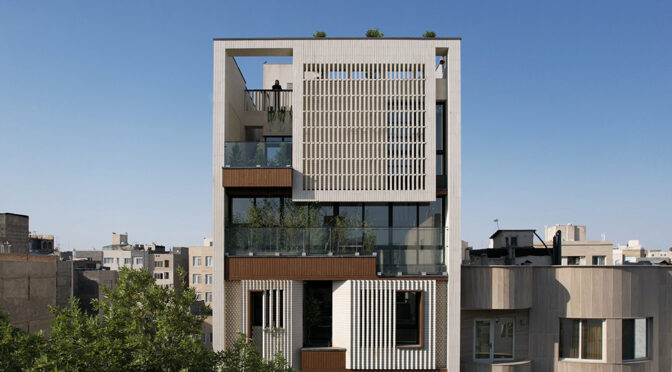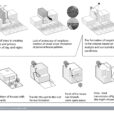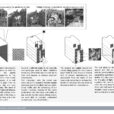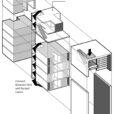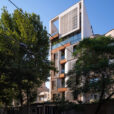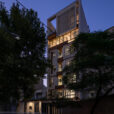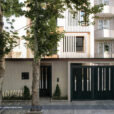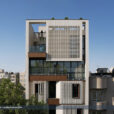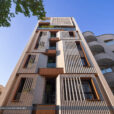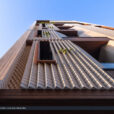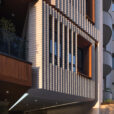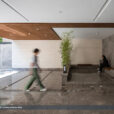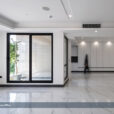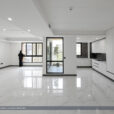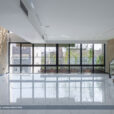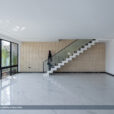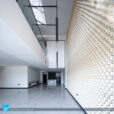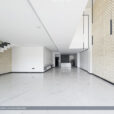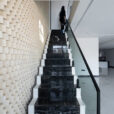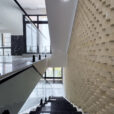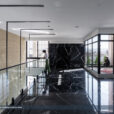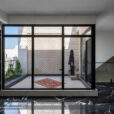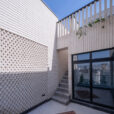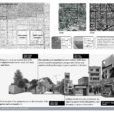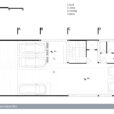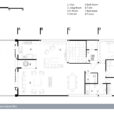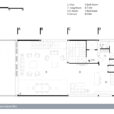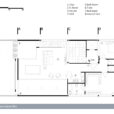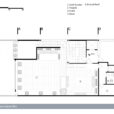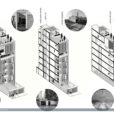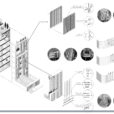میم انگور
دفتر معماری برساو (محمد ریحانی، علیرضا مدرسی، علی سویزی)
موقعیت: مشهد، ایران
تاریخ: ۱۴۰۳
مساحت: ۱،۳۵۱ مترمربع
وضعیت: ساختهشده
کارفرما: جواد جبرئیلی
تیم طراحی: حمیده صرافیان، متینه رضایی، فائزه صمدی، سارا وحیدیان، مریم نیکمهر، الهام مهدیان، بهار حاجیزاده، رضا روحی، سینا افتخار
سازه: حجت خزایینژاد
تاسیسات مکانیکی: حامد صفارزاده
تاسیسات الکتریکی: محمدمهدی فرزاد
اجرا: رضا دشتی
نظارت: علی سویزی، علیرضا مدرسی
فیلم: دایان مزرعی
عکس: استودیو دیمن، دایان مزرعی
کارفرمای پروژه، مردی پنجاهساله به همراه همسر و فرزندش بود که به دلیل تعلق خاطر عمیق به محله قدیمیشان، تصمیم گرفته بود آپارتمانی در این محله بسازد. او در نظر داشت یک واحد دوبلکس از پروژه را برای زندگی شخصی خود، و سایر واحدها را به عنوان مستغلات، برای استفاده احتمالی فرزندش در آینده اختصاص دهد. با توجه به اشتغال کارفرما به جواهرسازی، او حساسیت زیادی به جزئیات داشت و ارزش ویژهای برای هنر دست استادکاران قائل بود. از یکسو، او بر خاطرهانگیزی و تجربه دلنشین زندگی در خانههای حیاطدار تاکید داشت، و از سوی دیگر، به دنبال معماری لوکس و پر زرقوبرق بود. از اینرو، هدف اصلی پروژه، بازتعریف این خواستهها و ایجاد هماهنگی میان آنها و ویژگیهای تاریخی، فرهنگی و اقتصادی محله بود تا بتوان مفهوم متفاوتی از معماری لوکس را در معرض نمایش گذاشت، مفهومی که کیفیت و کاربردیبودن، و صمیمیت و خاطرهانگیزی را توامان در برگیرد.
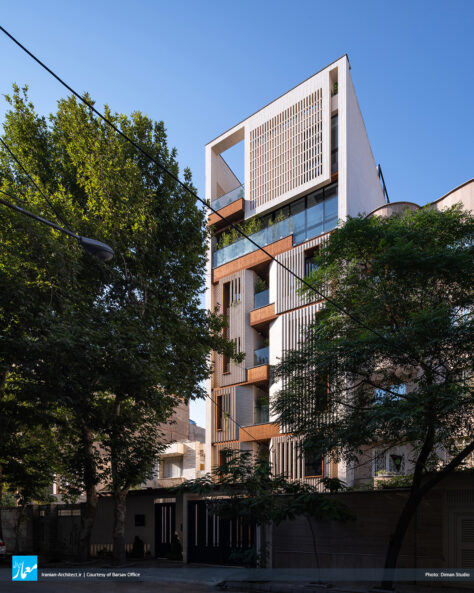
برای کاهش آشفتگی بصری ناشی از ساختمانهای اطراف، نمای پروژه با استفاده از آجر سفید، و بر پایه ایجاد قابی ساده و زیبا شکل گرفته است که بنا را از همسایگان ناهماهنگ و در حال نوسازی جدا میکند و فضایی مناسب برای چینش عناصر معماری فراهم میسازد. پوستههای آجری برگمانند نما که با چرخش و زاویهگیری قطعات آجر شکل گرفتهاند، نفوذپذیری متنوعی به حجم بیرونی میدهند، و با ایجاد روزنههایی، کنترل دید از بیرون به داخل را ممکن میسازند. همچنین بازی نور و سایه روی سطوح مایل آجری، جلوهای پویا در نما ایجاد میکند که تا عمق فضا امتداد مییابد. این شیوه از طراحی، نمایی سهبعدی پدید میآورد که علاوه بر مدیریت تابش آفتاب، تمرکز دید را از روبهرو به جهات شرقی و غربی تغییر میدهد و تجربههای بصری منحصربهفردی را در داخل و خارج بنا برای کاربران به ارمغان میآورد.
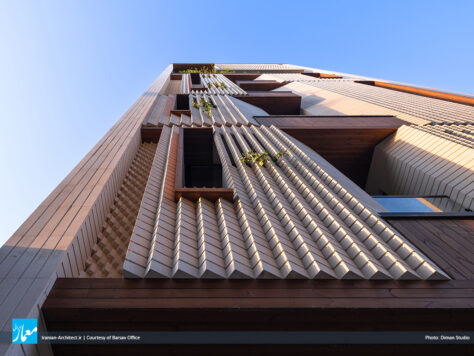
با توجه به عرض کم معبر و رفتوآمد زیاد در آن، و نیز اشراف خانهها بر یکدیگر، ارتباط با خیابان به فضاهای منفی همچون تراسها محدود شده است. این تراسها با نفوذ به عمق ساختمان، امکان دریافت نور طبیعی و دید به بیرون را برای فضاهایی مانند نشیمن فراهم میکنند. در دیوارههای جانبی تراسها نیز میتوان بازشوهایی در نظر گرفت که بدون ایجاد اشراف، تهویه طبیعی را ممکن میسازند. علاوه بر این، زاویهدار بودن لبه بیرونی تراسها، این امکان را به کاربران میدهد که گستره دید بیشتری تا عمق چند ده متری داشته باشند.
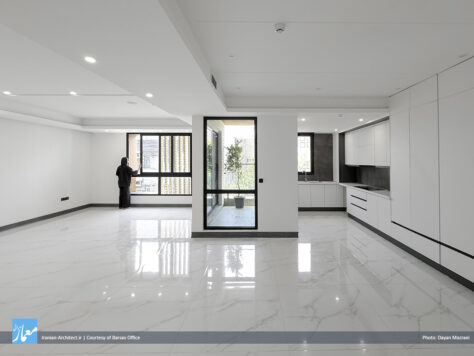
در طبقات یک تا چهار، هرکدام با مساحت ۱۶۰ مترمربع، فضایی میان آشپزخانه و سالن اصلی در نظر گرفته شده که از انعطافپذیری و قابلیت تبدیلپذیری بالایی برخوردار است. این فضا به شکلی طراحی شده است که میتواند بهطور مستقل، به عنوان کتابخانه، نشیمن، فضای سرگرمی یا محل تماشای تلویزیون استفاده شود. همچنین امکان اتصال آن به آشپزخانه (برای فضای آمادهسازی یا ناهارخوری) یا ادغامش با سالن اصلی نیز وجود دارد. کیفیت بصری، و تهویه و نورگیری مناسب این فضا، دستاورد طراحی تراسی است که از لبه نما به عمق پلان نفوذ کرده است. این تراس علاوه بر افزودن سبزینگی، به عنوان حائلی موثر میان فضای کار آشپزخانه و پذیرایی عمل میکند و حس آرامش و ارتباط با طبیعت را به فضا میبخشد.
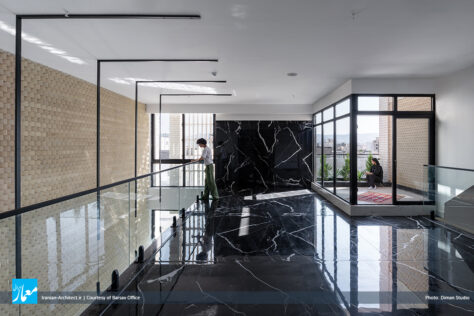
خانه کارفرما در طبقات پنج و شش، در قالب یک واحد دوبلکس طراحی شده است. لایه اول این خانه به فضای نشیمن و پذیرایی مهمان اختصاص یافته که به دلیل نبود اشراف ساختمانهای روبهرو، جداره آن کاملا شفاف در نظر گرفته شده است. در مقابل این جداره، باغچهای سرتاسری قرار دارد که با ایجاد پردهای سبز، منظره بام ساختمان مقابل را میپوشاند. لایه دوم خانه نیز شامل اتاقها، نشیمن و حیاط سرگشادهای در جداره جنوبی است که به درختان کهنسال چنار مشرف است. این نشیمن، مشابه ایوانهای خانههای سنتی، امکان اتصال مستقیم به حیاط سرگشاده را داراست و به وید اصلی، و از طریق آن به پذیرایی نیز اشراف دارد. حیاط سرگشاده نیز از طریق یک پله روباز، به لایه سوم که بخشی از بام ساختمان است، متصل میشود. این بام فضایی مناسب برای بازی کودکان، دورهمیهای خانوادگی، و سپریکردن لحظاتی دلنشین در شب را فراهم میکند.
Grapevine
Barsav Office (Mohammad Reyhani, Alireza Modarresi, Ali Soveizi)
Location: Mashhad, Iran
Date: 2024
Area: 1,351 sqm
Status: Completed
Client: Javad Jebreili
Design Team: Hamideh Sarafian, Matineh Rezaei, Faezeh Samadi, Sara Vahidian, Maryam Nikmehr, Elham Mahdian, Bahar Hajizadeh, Reza Rouhi, Sina Eftekhar
Structure: Hojjat Khazaeinejad
Mechanical Engineering: Hamed Saffarzadeh
Electrical Engineering: Mohamad Mahdi Farzad
Construction: Reza Dashti
Supervision: Ali Soveizi, Alireza Modarresi
Video: Dayan Mazraei
Photo: Diman Studio, Dayan Mazraei
The client of the project, a fifty-year-old man accompanied by his wife and child, decided to build an apartment in their old neighborhood due to his deep attachment to the area. He intended to allocate a duplex unit for his personal residence and reserve the other units as properties for potential use by his child in the future. Given the client’s engagement in jewelry-making, he displayed exceptional attention to detail and held great value for the craftsmanship of skilled artisans. On one hand, he emphasized the nostalgic charm and delightful experience of living in courtyard houses, and on the other hand, he aspired to a luxurious and ornate architectural design. Thus, the main goal of the project was to redefine these desires and establish harmony between them and the historical, cultural, and economic characteristics of the neighborhood, showcasing a distinctive concept of luxury architecture that embodies both quality and practicality, alongside intimacy and nostalgia.
To minimize the visual chaos caused by surrounding buildings, the project façade was designed using white bricks, forming a simple yet elegant frame that separates the building from the discordant and renovating neighbors while providing an appropriate space for architectural elements. Leaf-shaped brick cladding, crafted through rotations and angular brickwork, introduces diverse permeability to the external mass. These claddings create openings that regulate views from outside to inside. Additionally, the interplay of light and shadow across the inclined brick surfaces lends a dynamic expression to the façade that extends into the depth of the spaces. This design approach results in a three-dimensional façade that not only manages sunlight exposure but also shifts the focus from frontal views to the eastern and western directions, offering unique and enriching visual experiences both indoors and outdoors.
Considering the narrowness of the street and its high traffic, along with the overlooking nature of adjacent houses, the connection to the street has been limited to negative spaces such as terraces. These terraces, penetrating the depth of the building, provide natural light and outdoor views for spaces like living rooms. The side walls of the terraces feature openings designed to ensure privacy while enabling natural ventilation. Moreover, the angled outer edges of the terraces enhance the range of views, reaching several tens of meters into the distance.
In floors one through four, each measuring 160 square meters, a flexible and convertible space has been designed between the kitchen and the main hall. This space can independently serve as a library, living room, entertainment area, or television lounge. Additionally, it can be connected to the kitchen for purposes such as food preparation or dining, or merged with the main hall. The visual quality, ventilation, and adequate lighting of this space are achieved through a terrace that extends from the façade to the depth of the plan. Besides introducing greenery, this terrace acts as an effective buffer between the working space of the kitchen and the reception area, bringing a sense of tranquility and connection to nature.
The client’s residence is designed as a duplex unit on floors five and six. The first layer of this house is dedicated to the living room and guest reception area, with maximum transparency enabled by the absence of overlooking structures in front. A continuous garden in the southern edge forms a green curtain against the roof of the opposite building. The second layer includes bedrooms, a living room, and an open courtyard on the southern side overlooking the ancient plane trees. This living room, reminiscent of the verandas of traditional houses, offers direct access to the open courtyard and overlooks the main void, which is also connected to the reception area. The open courtyard is linked by an open staircase to the third layer, which is part of the building’s roof. This roof provides an ideal space for children’s play, family gatherings, and enjoying pleasant evenings.

